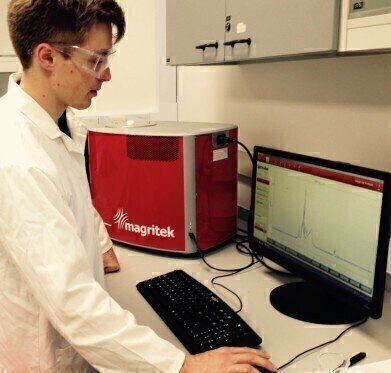Mass Spectrometry & Spectroscopy
Report on how Durham University is Applying a Benchtop NMR Spectrometer for Research and Teaching
Oct 28 2015
Dr Jonathan Harburn is a Lecturer in Medicinal Chemistry in the Wolfson Research Institute located in the School of Medicine, Pharmacy and Health at Durham University. NMR is one of the main tools in a medicinal chemist arsenal to confirm chemical transformation towards biologically active molecules and is used on a daily basis. For small molecule work, the Magritek Spinsolve provides a good indicator of chemical transformation especially fluorine incorporation or displacement.
Working together with Drs Stuart Cockerill and Jonathan Sellars, Dr Harburn's research goals are to create clinical drug candidates for the treatment of viruses, bacteria and cancer. They focus on hit identification programmes entailing a combination of computational modelling, modular synthetic chemistry and biological analysis to design, synthesise and evaluate inhibitors with a favourable toxicological and developability risk profile. Recent progress has focussed repurposing novel fluorinated drug fragments on known drug scaffolds to develop hit identification. 19F NMR using Spinsolve is one of the most useful tools in confirming fluorinated fragment incorporation with spectra run in 3 minutes. Also, 1H NMR is routinely carried out for identification before further spectral data is acquired on higher field NMR.
The innovative new MPharm programme is research-led to the extent that subject content is based largely on research interests of staff. In Level 2, students undertake a project in which they design, synthesise, analyse, microbiologically evaluate and formulate a sulphonamide drug analogue. This allows students to see the whole drug discovery and development process is action through immersion allowing for a deeper understanding. Students have to choose from a bank of 60 starting amines to probe three main areas affecting drug efficacy i.e. pKa, log P and size/shape. Before testing the antibacterial susceptibility, students must confirm the purity and success of the microwave assisted synthetic steps through hands-on use of the 1H NMR Spinsolve. The first step forms an acetamide which can be clearly seen as singlet -CH3 which disappears on hydrolysis in the second step.
Dr Harburn said that Spinsolve was chosen for a number of reasons: “It has a small footprint; it is robust (student friendly); and is inexpensive in comparison to purchase and operating costs for a high field NMR. In the near future, we are going to place this in series with our Syrris Africa Microfluidic System for online NMR of new chemical entity library generation under flow conditions. This would be tandem with online LC/MS and would give the opportunity to have very fast synthesis and analysis of hundreds of compounds overnight. Setup of Magritek will be very easy in comparison to a high field, supercooled NMR.”
Digital Edition
Lab Asia 31.2 April 2024
April 2024
In This Edition Chromatography Articles - Approaches to troubleshooting an SPE method for the analysis of oligonucleotides (pt i) - High-precision liquid flow processes demand full fluidic c...
View all digital editions
Events
May 05 2024 Seville, Spain
InformEx Zone at CPhl North America
May 07 2024 Pennsylvania, PA, USA
May 14 2024 Oklahoma City, OK, USA
May 15 2024 Birmingham, UK
May 21 2024 Lagos, Nigeria











.jpg)






